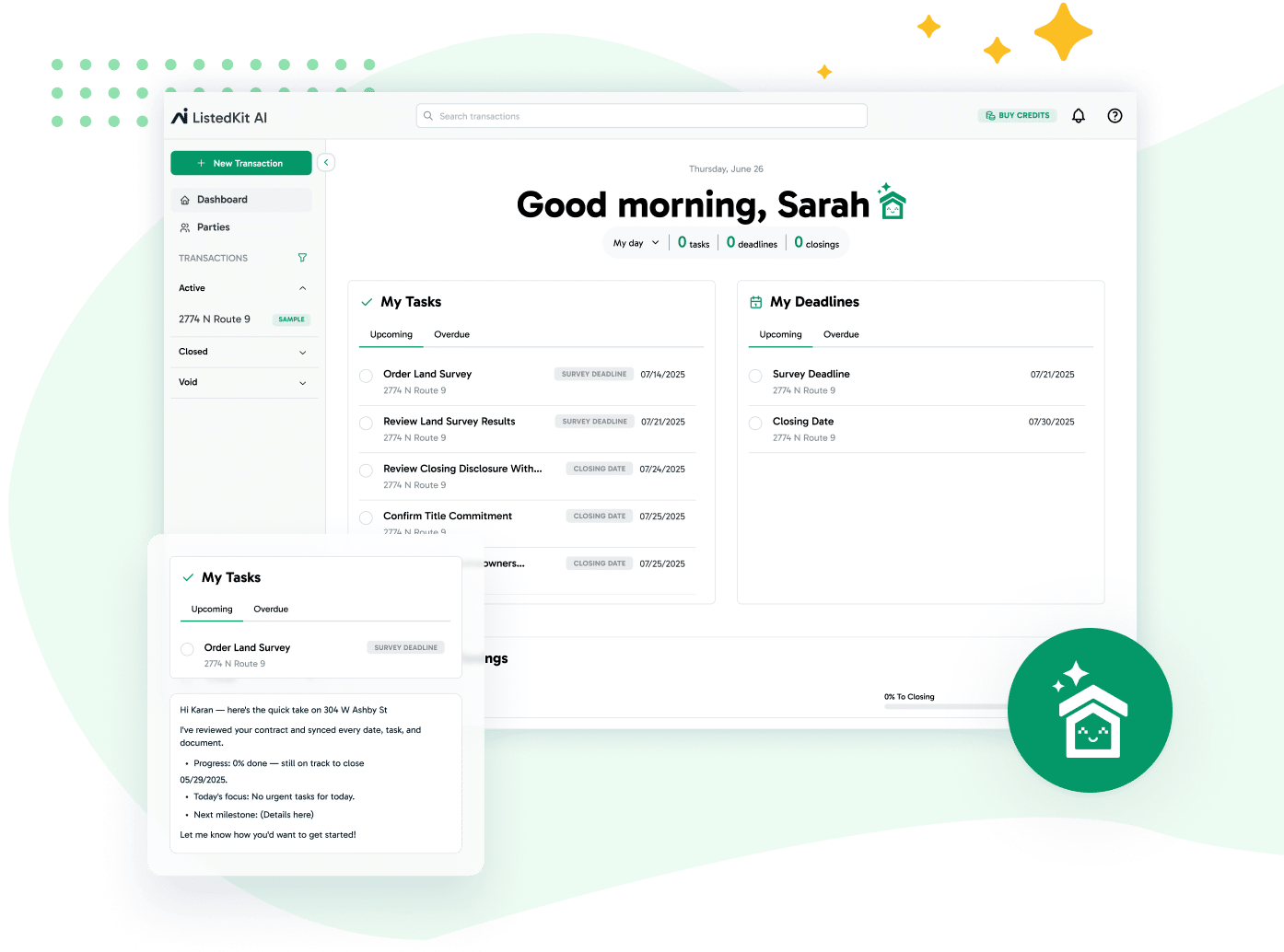Rather than just reacting to things as they come up, being a proactive transaction coordinator means anticipating issues, addressing them before they become problems and making the process smoother and more efficient.
This prevents miscommunication, reduces client stress, and builds stronger, more trusting relationships in the real estate industry.
In this post, we’ll look at practical ways to help you stay ahead of the game.
1. Anticipate Common Client Concerns Before They Become Issues
Real estate transactions have common pain points. Clients usually worry about tight transaction timelines, closing costs and documentation requirements.
By knowing these common issues, you can address them properly at the very beginning.
Here’s what you can do:
Prepare Answers to Frequently Asked Questions (FAQs)
Create a FAQ document or page for each stage of the transaction. This can include:
- What are the typical timelines for each phase of the transaction?
- What documents will I need to provide, and when?
- How are closing costs calculated, and what can I expect to pay?
- What happens if there are issues with the home inspection?
- How will you keep me updated throughout the process?
Share the answers with your clients early to set expectations and reduce anxiety on their part.
Schedule Regular Check-Ins
Schedule touchpoints to discuss potential issues. This prevents problems from escalating and keeps the transaction moving. Clients will love the service and trust your approach.
For instance, you can block Wednesdays and Fridays for quick check-ins to update clients on the transaction’s progress and address any concerns they may have.
By following these steps, you’re positioning yourself as a trusted and proactive transaction coordinator.
2. Create A Communication Plan For Every Transaction
A communication plan is crucial for independent transaction coordinators who want to stand out in a crowded market. It helps you manage real estate transactions smoothly and keeps your clients informed.
Customized Communication Strategy: Plan how often will you update clients, what communication channels you’ll use, and what are the key milestones. For example:
| Milestone | Communication Method | Frequency |
|---|---|---|
| Offer Acceptance | Immediate | |
| Inspection Completion | Phone Call | Within 24 Hours |
| Final Walkthrough | SMS/Text | One Week Before |
| Closing Confirmation | Email and Phone Call | Day Before Closing |
Set Expectations Early: At the beginning of each transaction, explain to your clients what information they will receive and how to contact you for urgent matters.
Use Automation Tools: Automation tools for communication management, like ListedKit, can send routine updates for you, saving you from manually reminding and emailing real estate agents and clients.
By following these, you’ll provide value, get better outcomes and grow as a real estate professional.
3. Send Updates Before Clients Ask
Keeping potential clients informed in real estate transactions without waiting for them to contact you first is a great way to provide exceptional service. It shows how serious you are about maintaining their trust and being transparent.
Here are some updates you can send to your clients.
Daily or Weekly Summaries
Send a quick summary of what’s been done, what’s next and what needs to be done. This keeps them in the loop.
For example, if you’re working on a listing and the inspection has just been done, you can send a summary of the inspection results, any repairs needed and the next steps in the timeline.
Visual Progress Tracking
Clients want to see where they are at a quick glance rather than read through paragraphs of text. For this, you can use ListedKit’s client portal where they can check real-time progress and updates more efficiently.
This portal shows completed tasks and upcoming steps so clients can have transparency and peace of mind throughout the buying or selling process.
Notify of Potential Delays Early
If there’s a chance of a closing delay, whether it’s due to financing, appraisal issues, or other unexpected things, notify the client immediately.
Explain the reason for the delay, what you’re doing to fix it and how it will impact the overall timeline. By being upfront about potential setbacks, you’re being transparent and showing you’re committed to keeping the transaction on track.
Real-Time Updates
Use technology to send real-time updates on major milestones. For example, when a big step like appraisal or loan approval is taken, notify your clients through their preferred method – email, Slack, project management, or a transaction management platform.
This will give them peace of mind that the process is moving and you manage every transaction detail.
If you’re looking to enhance your transaction management process, it’s worth evaluating the various technology alternatives available. Check out this blog post to explore the best real estate transaction coordinator software.
4. Prepare Clients For Each Step Ahead Of Time
Setting clear expectations and guiding clients through each stage of the transaction process is essential for minimizing surprises and ensuring a seamless experience. Here’s how you can stay ahead:
- Educational Guides: Give clients a step-by-step guide to the transaction process, what’s required from them and what to expect. This reduces uncertainty and empowers them to be proactive too.
- Preemptive Document Requests: Anticipate what documents will be needed and request them in advance. This prevents delays and keeps the process moving.
- Role-Playing: Walk clients through possible scenarios or challenges that may arise during the transaction and make them feel more prepared and in control.
- Flexible Meetings: Offer flexible meeting times to fit your clients’ schedules. This increases engagement and makes the whole process easier.
- Conflict Prevention: Identify conflict prevention by having open communication. Discuss potential hotspots well in advance and find creative solutions to these issues.
- Time for Decisions: Give your clients time to review documents and make informed decisions. Hasty decisions can mean missed details and later complexity.
By doing this, you’ll provide a more personal service and a solid foundation for a smooth transaction.
5. Communicate Across Multiple Parties
One of the things about being a transaction coordinator is that you’re not just working with one real estate agent; you’re working with buyers, sellers, lenders, inspectors, attorneys, and other ancillary services.
With so many moving parts, communication across all these parties is important to keep the transaction on track.
Using a transaction management platform that allows you to share documents and send emails ensures you can bring everyone on the same page. No communication or data silos.
Having a primary point of contact in each process is also very important. So, if you have a question about inspection deadlines, legal issues, or loan approvals, you’ll be talking to one person alone. This reduces confusion and ensures any questions get directed to the right person.
As a TC, you must also document everything—communications, decisions, and changes. These records are a reference point if questions arise during the transaction.
Lastly, having specific lines of communication for different tasks or situations prevents poor communication and smoother the overall transaction.
Use email for formal documentation, messaging apps for quick informal chats, and phone calls for urgent matters as the closing date approaches.
Closing Thoughts
Proactive communication in real estate transactions not only makes the process easier but also leaves your clients happier and more confident in you.
By getting ahead of the issues and consistently keeping clients informed, you’ll have a seamless experience and be the transaction coordinator they want to work with in the long term. Do this to be in control, reduce stress, and deliver results.
Consider using software like ListedKit to take your proactive approach to the next level. Its powerful features like client portals, automated updates, and centralized document sharing, can help you deliver exceptional service every time.




